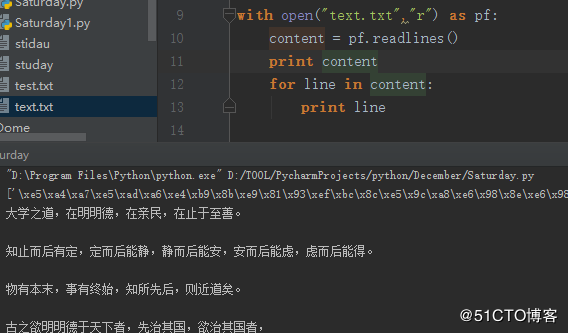python文件操作二
发布时间:2019-09-02 07:41:55编辑:auto阅读(2085)
- fileObject.read([size])
size为读取的长度,以byte为单位。如果不指定参数,表示一次性读取全部
内容,以字符串形式返回,并且每一行结尾会有一个"\n"符号。
代码示例1:with open("text.txt","r") as pf: content = pf.read() print content - fileObject.readline( [size] )
一行,如果给定了size,有可能返回的只是一行的一部分,以字符串的形式返
回,并且结尾会有一个换行符"\n"。读完一行,文件操作标记移动到下一行的
开头
列题1 - fileObject.readlines( [size] )
把文件每一行作为一个list的一个成员,是一个字符串,并且结尾会一个换行符"\n",并返回这个list。这个函数的内部是通过循环调用readline()来实现的。如果指定了size参数,表示读取文件指定内容的长度,此时就有可能只能读取文件的一部分 - fileObject.write( str )
把str写到文件中,默认是不加换行符的,所以如果想换行的话,得手动加入换行符' - fileObject.writelines( seq )
把seq(序列)的内容全部写到文件中(多行一次性写入)。也不会自动加入换行符
如: - fileObject.close()
File 对象的 close()方法刷新缓冲区里任何还没写入的信息,并关闭该文件,这之后便不能再进行写入。当一个文件对象的引用被重新指定给另一个文件时,Python 会关闭之前的文件。用 close()方法关闭文件是一个很好的习惯。如果文件关闭后,还对文件进行操作就会产生ValueError错误,但如果不及时关闭文件,有可能产生句
柄泄露,丢失数据
#打开文件准备写文件 -
fileObject.flush()
该函数是将缓冲区中的内容写入硬盘 - fileObject.tell()
返回文件操作标记的当前位置,以文件的开头为基准点 - fileObject.seek( offset[, from ] )
tell()方法告诉你文件内的当前位置;换句话说,下一次的读写会发生在文件开头这么多字节之后。seek(offset [,from])这是一个文件定位函数,该方法改变当前文件的位置。 Offset变量表示要移动的字节数。From变量指定开始移动字节的参考位置。如果from被设为0(默认值),这意味着将文件的开头作为移动字节的参考位置。如果设为1,则使用当前的位置作为参考位置。如果它被设为2,那么该文件的末尾将为参考位置。需要注意,如果文件以a或a+的模式打开,每次进行写操作时,文件操作标记会自动返回到文件末尾。测试文件test.txt,内容如下: linecache
模块允许从任何文件里得到任何的行,并且使用缓存进行优化,常见的情况是从单
个文件读取多行。- linecache.getlines(filename)
从名为 filename 的文件中得到全部内容,输出为列表格式,以文件每行为列表中的一个元素,
并以 linenum-1 为元素在列表中的位置存储 - linecache.getline(filename,lineno)
从名为 filename 的文件中得到第 lineno 行。这个函数从不会抛出一个异常–产生错误时它将
返回”(换行符将包含在找到的行里)。
如果文件没有找到,这个函数将会在 sys.path 搜索。 - linecache.clearcache()
清除缓存,如果你不再需要先前从 getline() 中得到的行 - linecache.checkcache(filename)
检查缓存的有效性。如果在缓存中的文件在硬盘上发生了变化,并且你需要更新版本,使用
这个函数,执行此函数会讲淘汰的内容删除。如果省略 filename,将检查缓存里的所有条目。 - linecache.updatecache(filename)
更新文件名为 filename 的缓存。如果 filename 文件更新了,使用这个函数可以更新 -
linecache.getlines(filename)
返回的列表。如果出错,则返回空列表。- 删除空行的方法
1、常用函数:
结果:
abcede
123
this is a test文件操作jfedcba
代码示例2:
with open("text.txt","r") as pf:
content = pf.read(2)
print content结果:
读取:ab
with open("text.txt","r") as pf:
content = pf.readline()
print content
结果:
大学之道,在明明德,在亲民,在止于至善。
列题 1:
with open("text.txt","r") as pf:
content = pf.readline(15)
print content
结果:
大学之道,
with open("text.txt","r") as pf:
content = pf.readlines()
print content
for line in content:
print line结果:
with open("test.txt","w") as pf:
pf.write("我是最帮的!!\n学习文件写入操作")结果:
我是最帮的!!
学习文件写入操作
content = "我是最帮的!!\n学习文件写入操作,加油!!!"
with open("test.txt","a") as pf:
pf.writelines(content)
结果:
我是最帮的!!
学习文件写入操作我是最帮的!!
学习文件写入操作,加油!!!
fp = open( "c:\\test.txt",'w')
print u"文件名:", fp.name
#关闭文件
fp.close()
print u"文件是否关闭:", fp.closed结果:
文件名: test.txt
文件是否关闭: True
with open("test.txt","r") as pf:
print u"当前文件操作标记位置为:", pf.tell()
line = pf.readline()
print u"读取一行后文件操作标记位置为:", pf.tell()结果:
当前文件操作标记位置为: 0
读取一行后文件操作标记位置为: 23
with open("test.txt","r") as fp:
str = fp.read(18)
print u"读取的字符串是 : ", str
# 查找当前位置
position = fp.tell()
print u"当前文件位置 : ", position
# 把指针再次重新定位到文件开头
position = fp.seek(0, 0)
str = fp.read(18)
print u"重新读取字符串 : ", str
结果:
读取的字符串是 : 我是最帮的!
当前文件位置 : 18
重新读取字符串 : 我是最帮的!
fileObject.truncate( [size] )
把文件裁成规定的大小,默认的是裁到当前文件操作标记的位置。如果size比件的大小还要大,依据系统的不同可能是不改变文件,也可能是用0把文件补到相应的大小,也可能是以一些随机的内容加上去。
with open("test.txt","r") as fp:
print "Name of the file: ", fp.name
line = fp.readline()
print "Read Line: %s" % (line)
print fp.tell()
# Try to read file now
remainingLine = fp.readline()
print "Read Line: %s" % (remainingLine)
fp = open(r'test.txt')
aList = []
for item in fp:
if item.strip():
aList.append(item)
fp.close()
fp = open(r'test2.txt', 'w')
fp.writelines(aList)
def delblankline(infile, outfile):
""" Delete blanklines of infile """
infp = open(infile, "r")
outfp = open(outfile, "w")
lines = infp.readlines()
for li in lines:
if li=='\n': #不同操作系统下可能会有不同
print u'空行'
if li.split():
outfp.write(li)
infp.close()
outfp.close()
if __name__ == "__main__":
delblankline("c:\\1.txt","c:\\2.txt")
列题:
数据文件:data.log
20160215 000148|0|collect info job start|success|
20160215000153|0|collect info job
end|success|resultcode = 0000
20160216000120|0|collect info job start|success|
20160216000121|0|collect info job
end|success|resultcode = 0000
20160217000139|0|collect info job start|success|
20160217000143|0|collect info job
end|success|resultcode = 0000
数据分析需求:
每行内容需要生成以每行
首年月日为名称的文件,
文件内容写入|0|后的所有
行内容(也包括|0| )
算法分析:
遍历每一行,每行取头8个字母
新建文件,文件名为首8个字母,然后把第15字符后的所有字
符拷贝到文件中
关闭文件
fp =open("e:\\data.log")
for line in fp.readlines():
filename = line[:14]
content = line[14:]
with open("e:\\"+filename+".txt","w") as fp2:
fp2.write(content+"\n")
fp.close()
上一篇: python dict
下一篇: python 文件 目录操作
- openvpn linux客户端使用
51693
- H3C基本命令大全
51348
- openvpn windows客户端使用
41786
- H3C IRF原理及 配置
38557
- Python exit()函数
33031
- openvpn mac客户端使用
30056
- python全系列官方中文文档
28718
- python 获取网卡实时流量
23708
- 1.常用turtle功能函数
23632
- python 获取Linux和Windows硬件信息
21995
- Python搭建一个RAG系统(分片/检索/召回/重排序/生成)
2193°
- Browser-use:智能浏览器自动化(Web-Agent)
2888°
- 使用 LangChain 实现本地 Agent
2403°
- 使用 LangChain 构建本地 RAG 应用
2352°
- 使用LLaMA-Factory微调大模型的function calling能力
2919°
- 复现一个简单Agent系统
2355°
- LLaMA Factory-Lora微调实现声控语音多轮问答对话-1
3151°
- LLaMA Factory微调后的模型合并导出和部署-4
5181°
- LLaMA Factory微调模型的各种参数怎么设置-3
5005°
- LLaMA Factory构建高质量数据集-2
3578°
- 姓名:Run
- 职业:谜
- 邮箱:383697894@qq.com
- 定位:上海 · 松江
